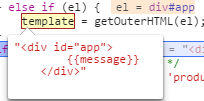这篇文章主要介绍Vue中AST源码解析的示例分析,文中介绍的非常详细,具有一定的参考价值,感兴趣的小伙伴们一定要看完!
从这个函数开始的:
// Line-3924
Vue.prototype._init = function(options) {
// 大量初始化
// ...
// Go!
if (vm.$options.el) {
vm.$mount(vm.$options.el);
}
};弄完data属性的数据绑定后,开始处理el属性,也就是挂载的DOM节点,这里的vm.$options.el也就是传进去的'#app'字符串。
有一个值得注意的点是,源码中有2个$mount函数都是Vue$3的原型函数,其中一个标记了注释public mount method,在7531行,另外一个在9553行。打断点进入的是后面,因为定义的晚,覆盖了前面的函数。
// Line-7531
// public mount method
Vue$3.prototype.$mount = function(el,hydrating) {
el = el && inBrowser ? query(el) : undefined;
return mountComponent(this, el, hydrating)
};
// Line-9552
var mount = Vue$3.prototype.$mount;
Vue$3.prototype.$mount = function(
el,
hydrating
) {
// ...很多代码
return mount.call(this, el, hydrating)
};现在进入后面的$mount函数看看内部结构:
// Line-9552
var mount = Vue$3.prototype.$mount;
Vue$3.prototype.$mount = function(el,hydrating) {
// 将el格式化为DOM节点
el = el && query(el);
// 判断是否挂载到body或者html标签上
if (el === document.body || el === document.documentElement) {
"development" !== 'production' && warn(
"Do not mount Vue to <html> or <body> - mount to normal elements instead."
);
return this
}
var options = this.$options;
// 处理template/el 转换为渲染函数
if (!options.render) {
// ...非常多代码
}
return mount.call(this, el, hydrating)
};代码前半段首先将el转换为DOM节点,并判断是否挂载到body或者html标签,看看简单的query函数:
// Line-4583
function query(el) {
// 如果是字符串就调用querySelector
if (typeof el === 'string') {
var selected = document.querySelector(el);
if (!selected) {
"development" !== 'production' && warn(
'Cannot find element: ' + el
);
// 找不到就返回一个div
return document.createElement('div')
}
return selected
}
// 不是字符串就默认传进来的是DOM节点
else {
return el
}
}函数比较简单,值得注意的几个点是,由于调用的是querySelector方法,所以可以传标签名、类名、C3新选择器等,都会返回查询到的第一个。当然,总是传一个ID或者确定的DOM节点才是正确用法。
下面看接下来的代码:
// Line-9552
var mount = Vue$3.prototype.$mount;
Vue$3.prototype.$mount = function(el,hydrating) {
// ...el转换为DOM节点
// ...
// 没有render属性 进入代码段
if (!options.render) {
var template = options.template;
// 没有template 跳
if (template) {
if (typeof template === 'string') {
if (template.charAt(0) === '#') {
template = idToTemplate(template);
/* istanbul ignore if */
if ("development" !== 'production' && !template) {
warn(
("Template element not found or is empty: " + (options.template)),
this
);
}
}
} else if (template.nodeType) {
template = template.innerHTML;
} else {
{
warn('invalid template option:' + template, this);
}
return this
}
}
// 有el 获取字符串化的DOM树
else if (el) {
template = getOuterHTML(el);
}
if (template) {
// ...小段代码
}
}
return mount.call(this, el, hydrating)
};由于没有template属性,会直接进入第二个判断条件,调用getOuterHTML来初始化template变量,函数比较简单, 来看看:
// Line-9623
function getOuterHTML(el) {
if (el.outerHTML) {
return el.outerHTML
}
// 兼容IE中的SVG
else {
var container = document.createElement('div');
container.appendChild(el.cloneNode(true));
return container.innerHTML
}
}简单来讲,就是调用outerHTML返回DOM树的字符串形式,看图就明白了:

下面看最后一段代码:
// Line-9552
var mount = Vue$3.prototype.$mount;
Vue$3.prototype.$mount = function(el,hydrating) {
// ...el转换为DOM节点
// ...
// 没有render属性 进入代码段
if (!options.render) {
// ...处理template
// ...
if (template) {
// 编译开始
if ("development" !== 'production' && config.performance && mark) {
mark('compile');
}
// 将DOM树字符串编译为函数
var ref = compileToFunctions(template, {
shouldDecodeNewlines: shouldDecodeNewlines,
delimiters: options.delimiters
}, this);
// options添加属性
var render = ref.render;
var staticRenderFns = ref.staticRenderFns;
options.render = render;
options.staticRenderFns = staticRenderFns;
// 编译结束
if ("development" !== 'production' && config.performance && mark) {
mark('compile end');
measure(((this._name) + " compile"), 'compile', 'compile end');
}
}
}
return mount.call(this, el, hydrating)
};忽略2段dev模式下的提示代码,剩下的代码做了3件事,调用compileToFunctions函数肢解DOM树字符串,将返回的对象属性添加到options上,再次调用mount函数。
首先看一下compileToFunctions函数,该函数接受3个参数,分别为字符串、配置对象、当前vue实例。
由于函数比较长,而且部分是错误判断,简化后如下:
// Line-9326
function compileToFunctions(template,options,vm) {
// 获取配置参数
options = options || {};
// ...
var key = options.delimiters ?
String(options.delimiters) + template :
template;
// 检测缓存
if (functionCompileCache[key]) {
return functionCompileCache[key]
}
// 1
var compiled = compile(template, options);
// ...
// 2
var res = {};
var fnGenErrors = [];
res.render = makeFunction(compiled.render, fnGenErrors);
var l = compiled.staticRenderFns.length;
res.staticRenderFns = new Array(l);
for (var i = 0; i < l; i++) {
res.staticRenderFns[i] = makeFunction(compiled.staticRenderFns[i], fnGenErrors);
}
// ...
// 3
return (functionCompileCache[key] = res)
}可以看到,这个函数流程可以分为4步,获取参数 => 调用compile函数进行编译 => 将得到的compiled转换为函数 => 返回并缓存。
第一节现在这样吧。一张图总结下:

以上是“Vue中AST源码解析的示例分析”这篇文章的所有内容,感谢各位的阅读!希望分享的内容对大家有帮助,更多相关知识,欢迎关注亿速云行业资讯频道!
免责声明:本站发布的内容(图片、视频和文字)以原创、转载和分享为主,文章观点不代表本网站立场,如果涉及侵权请联系站长邮箱:is@yisu.com进行举报,并提供相关证据,一经查实,将立刻删除涉嫌侵权内容。